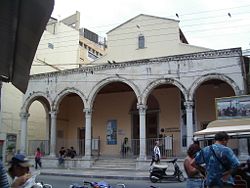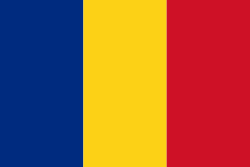Heraklion
| Heraklion Ηράκλειο |
|
|---|---|
 St. Mark basilica, built in 1239. Currently it houses the Municipal Art Gallery |
|
| Location | |
 |
|
| Coordinates | |
| Time zone: | EET/EEST (UTC+2/3) |
| Elevation (min-max): | 0 - 33 m (0 - 108 ft) |
| Government | |
| Country: | Greece |
| Periphery: | Crete |
| Prefecture: | Heraklion |
| Mayor: | Giánnis Kourákis |
| Population statistics (as of 2001[1]) | |
| City Proper | |
| - Population: | 137,711 |
| - Area:[2] | 109.026 km² (42 sq mi) |
| - Density: | 1,263 /km² (3,271 /sq mi) |
| Codes | |
| Postal: | 70x xx, 71x xx, 720 xx |
| Telephone: | 2810 |
| Auto: | HK, HP |
| Website | |
| www.heraklion-city.gr | |
Heraklion or Iraklion (Greek: Ηράκλειο, Irákleio, IPA: [iˈɾaklio̞]; Venetian: Candia), is the largest city and capital of Crete. It is also the fourth largest city in Greece. Its name is also spelled Herakleion, a transliteration of the ancient Greek and Katharevousa name, Ἡράκλειον, or Iraklio, among other variants. For centuries it was known as Candia, a Venetian adaptation of the earlier Greek name Χάνδαξ or Χάνδακας, which in turn came from the Arabic rabḍ al-ḫandaq. Under the Ottoman Empire, it was called Kandiye. In the local vernacular, it is often called Κάστρο (Kástro, "castle") and its inhabitants Καστρινοί (Kastrinoí, "castle dwellers").
Heraklion is the capital of Heraklion Prefecture, with an international airport named after the writer Nikos Kazantzakis. The ruins of Knossos, which were excavated and restored by Arthur Evans, are nearby.
Contents |
History
Heraklion is close to the ruins of the palace of Knossos, which in Minoan times was the largest centre of population on Crete. This Bronze Age palace and human settlement has yielded significant archaeological finds that have given insights to the Minoan civilisation.[3] It is likely that there was a port at Heraklion as long ago as 2000 BC, although no archaeological recovery has been made of the port itself.
Founding
The present city of Heraklion was founded in 824 AD by the Saracens who had been expelled from Al-Andalus by Emir Al-Hakam I and had taken over the island from the Byzantine Empire. They built a moat around the city for protection, and named the city ربض الخندق rabḍ al-ḫandaq 'Castle of the Moat'. The Saracens allowed the port to be used as a safe haven for pirates who operated against Byzantine shipping and raided Byzantine territory around the Aegaean.
Byzantine Era
- Further information: Byzantine Greece
In 961, the Byzantines, under the command of Nikephoros Phokas, later to become Byzantine Emperor, landed in Crete and attacked the city. After a prolonged siege, the city fell. The Saracen inhabitants were slaughtered, the city looted and burned to the ground. Soon rebuilt, the town of Chandax remained under Byzantine control for the next 243 years.
Venetian Era
- Further information: Republic of Venice
In 1204, the city was bought by the Republic of Venice as part of a complicated political deal which involved among other things, the Crusaders of the Fourth Crusade restoring the deposed Byzantine emperor Isaac II Angelus to his throne. The Venetians improved on the ditch by building enormous fortifications, most of which are still in place, including a giant wall, in places up to 40 m thick, with 7 bastions, and a fortress in the harbour. Chandax was renamed to Candia in Italian and became the seat of the Duke of Candia. As a result, the Venetian administrative district of Crete became known as "Regno di Candia" (Kingdom of Candia). The city retained the name of Candia for centuries and the same name was often used to refer to the whole island of Crete as well. To secure their rule, Venetians began in 1212 to resettle families from Venice on Crete. The coexistence of two different cultures and the influence of Italian Renaissance lead to a flourishing of letters and the arts in Candia and Crete in general, that is today known as the Cretan Renaissance.
Ottoman Era
After the Venetians came the Ottoman Empire. During the Cretan War (1645–1669), the Ottomans besieged the city for 22 years, from 1648 to 1669, the second-longest siege in history. In its final phase, which lasted for 22 months, 70,000 Turks, 38,000 Cretans and slaves and 29,088 of the city's Christian defenders perished.[4] Under the Ottomans, the city was known officially as Kandiye (again also applied to the whole island of Crete) but informally in Greek as Megalo Kastro ("Big Castle"). During the Ottoman period, the harbour silted up, so most shipping shifted to Hania in the north of the island.
Modern Era
In 1898 the autonomous Cretan State was created, under Ottoman suzerainty, with Prince George of Greece as its High Commissioner and under international supervision. During the period of direct occupation of the island by the Great Powers (1898-1908), Candia was part of the British zone. At this time the city was renamed "Heraklion", after the Roman port of Heracleum ("Heracles' city"), whose exact location is unknown.
With the rest of Crete, Heraklion was incorporated into the Kingdom of Greece in 1913. The biggest monument of the city is the Venetian medieval fortress Rocca al Mare (also known as Koules, Turkish for "tower") located at the port.
Transportation
Port
Heraklion is an important shipping port and ferry dock. The public can take ferries and boats from Heraklion to a multitude of destinations including Thira, Rhodes, Egypt, Haifa and mainland Greece.
Airport

Heraklion International Airport, or Nikos Kazantzakis Airport is located about 5km east of the city. The airport is named after Herkalion native Nikos Kazantzakis, a Greek writer and philosopher. It is the second busiest airport of Greece, mostly due to the fact that Crete is a major destination for tourists during summer. There are regular domestic flights to and from Athens, Thessaloniki and Rhodes with Aegean Airlines and Olympic Airlines. Cyprus Airways and Aegean Airlines fly to Larnaca. Furthermore, Sky Express operates direct flights to Aegean islands such as Rhodes, Santorini, Samos, Kos, Mytilini and Ikaria. During the summer period, traffic is intense and the flight destinations are from all over Europe (mostly Germany, UK, Italy and Russia). The airfield is shared with the 126 Combat Group of the Hellenic Air Force. The take off in western direction leads directly over the town of Heraklion, which makes it a very noisy city.
Highway Network
European route E75 runs through the city and connects Heraklion with the three other major cities of Crete: Agios Nikolaos,Chania, and Rethymno.
Public transit
There are a number of buses serving the city and connecting it to many major destinations in Crete.
Climate
Crete has a warm Mediterranean climate. Summers in the lowlands, are hot and dry with clear skies. Dry hot days are often relieved by a system of seasonal breezes. The mountain areas are much cooler, with considerable rain. Winters are mild in the lowlands with rare frost and snow. Although Heraklion is further south than Athens, it has a milder climate.
| Month | Jan | Feb | Mar | Apr | May | Jun | Jul | Aug | Sep | Oct | Nov | Dec | Year |
|---|---|---|---|---|---|---|---|---|---|---|---|---|---|
| Average high °F (°C) | 59 (15) |
60 (16) |
62 (17) |
68 (20) |
74 (23) |
81 (27) |
84 (29) |
83 (28) |
80 (27) |
74 (23) |
68 (20) |
63 (17) |
70 (21) |
| Average low °F (°C) | 48 (9) |
48 (9) |
50 (10) |
54 (12) |
59 (15) |
66 (19) |
71 (22) |
71 (22) |
67 (19) |
62 (17) |
56 (13) |
52 (11) |
59 (15) |
| Precipitation inches (mm) | 3.7 (94) |
2.6 (66) |
1.9 (48.3) |
1.1 (27.9) |
0.6 (15.2) |
0.1 (2.5) |
0 (0) |
0 (0) |
0.7 (17.8) |
2.3 (58.4) |
2.6 (66) |
3.5 (88.9) |
19.6 (497.8) |
| Source: [5] 2008-09-23 | |||||||||||||
Colleges and Universities
- University of Crete
- TEI of Crete
- Foundation for Research & Technology - Hellas
Culture


Museums
- Heraklion Archaeological Museum
- Historical Museum of Crete
- Natural History Museum
- The Battle of Crete and National Resistance Museum
- Museum of The Saint Catherine's Monastery of Sinai
- Museum of Visual Arts
Sports
The city hosts three football clubs:
- OFI Crete in Heraklion, plays in the first division.
- Ergotelis FC - in Heraklion, plays in the first division.
Both OFI and Ergotelis FC use the Pankritiko Stadium, which was built for the Athens 2004 Summer Olympics.
- Atsalenios - Football Club of Heraklion which plays in the third division.
Famous natives
Heraklion has been the home town of some of Greece's most significant spirits, including the novelist Nikos Kazantzakis, the poet and Nobel Prize winner Odysseas Elytis and the world-famous Greek painter Domenicos Theotokopoulos (El Greco).
Literature
- Vitsentzos Kornaros (1553-1613) author
- Nikos Kazantzakis (1883-1957) author
- Elli Alexiou (1894-1988) author
- Odysseas Elytis (1911-1996) Nobel awarded poet
- Lili Zografou (1922-1998) author
- Rea Galanaki (1947-present) author
Scientists and Scholars
- Peter Phillarges (ca. 1339-1410) (also Pietro Di Candia, later Pope Alexander V)
- Francesco Barozzi (1537-1604) mathematician and astronomer
- Maximos (Emmanuel) Margounios (1549–1602) scholar, theologian, poet and writer, titular bishop of Kythira
- Nikolaos Panagiotakis (1935-1997) byzantinologist
- Fotis Kafatos biologist, President of the European Research Council
- Joseph Sifakis (1946-present) computer scientist, co-recipient of the 2007 Turing Award
Painting
- Andreas Ritzos (1422-1492) painter of icons
- Theophanes (ca.1500-1559) painter of icons
- Michael Damaskenos (1530/35-1592/93) painter of icons
- Georgios Klontzas (1540-1607) painter of icons
- El Greco (1541-1614) mannerist painter, sculpturer and architect
- Emmanuel Tzanes (1610-1690) painter of icons
- Theodoros Poulakis (1622-1692) painter of icons
- Konstantinos Volanakis (1837-1907) painter
- Aristidis Vlassis (*1955) painter
Film industry
- Sapfo Notara (1907-1985) actress
- Rika Diallina (1934) actress and model, Miss Hellas
- Yannis Smaragdis (1946) film director
Music
- Fragiskos Leontaritis (Francesco Londarit) (1518-1572) composer
- Rena Kyriakou (1918-1994) pianist
- Giannis Markopoulos (1939) composer
- Christos Leontis (1940) composer
- Manolis Rasoulis (1945) lyrics writer
- Notis Sfakianakis (1959) singer
Sports
- Nikos Machlas (1973) footballer
- Georgios Samaras (1985) footballer
Business
- Gianna Angelopoulos-Daskalaki (1955) business woman and politician
Politics
- Georgios Voulgarakis (1959) politician
Law
- Romilos Kedikoglou (1940) President of the Court of Cassation of Greece
Clergy
- Kyrillos Loukaris (1572–1637) theologian, Patriarch of Alexandria as Cyril III and Ecumenical Patriarch of Constantinople as Cyril I
- Theodore II (1954) Patriarch of Alexandria
Fashion
- Maria Spiridaki (1984) fashion model and television presenter
Sister cities
 Constanţa, Romania
Constanţa, Romania
See also
- Centre for Technological Research of Crete
- European Network and Information Security Agency
- Foundation for Research & Technology - Hellas
- Minoan civilization
- Siege of Candia (1648 - 1669)
- TEI of Crete
- University of Crete
Notes
- The War for Candia by the VENIVA consortium provides details of the siege of Candia, including estimated number of deaths.
References
- ↑ "PDF (875 KB) 2001 Census" (in Greek). National Statistical Service of Greece (ΕΣΥΕ). www.statistics.gr. Retrieved on 2007-10-30.
- ↑ (Greek) "Basic Characteristics". Ministry of the Interior. www.ypes.gr. Retrieved on 2007-08-07.
- ↑ C. Michael Hogan, Knossos fieldnotes, Modern Antiquarian (2007) [1]
- ↑ The War for Candia
- ↑ "Iraklion". Weatherbase. Retrieved on 2008-09-23.
External links
- Municipality of Heraklion
- Heraklion Information about the city of Heraklion by the Technological Educational Institute of Crete
- Heraklion travel guide from Wikitravel
- dmoz.org on Heraklion
|
|||||
|
|||||
|
|||||